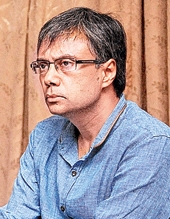
Heritage is not just about space or property.
It encompasses people, their livelihood, culture as well as natural, economic and political aspects.
Just as the term "heritage" needs to be more inclusive, the list of such buildings in the city needs to be more elaborate.
This was the general consensus at a round-table discussion on heritage conservation organised by the People United for Better Living in Calcutta (PUBLIC) at Nandan 4 on Monday.
A select group of authors, conservationists, architects and civic officials discussed problems related to heritage buildings in the city, the economic hurdles in the way of conservation and how the disadvantages can be turned around.
Giving them tips were two conservationists - Rabindra Vasavada and Sanjay Sridhar. While architect Vasavada is the head of the postgraduate programme in conservation studies at Ahmedabad's Centre for Environmental Planning and Technology University, Sridhar is the director (south and southeast Asia) of C40 Cities Climate Leadership Group.
C40 is a network of the world's megacities committed to addressing climate change.
The two introduced their concept, Urban Research Lab, to the guests explaining how their work and extensive research has helped "integrate" all aspects of urban development and "initiate" a better way of heritage conservation at six locations, including Bangalore, Ahmedabad and Badami.
Calcutta was made part of the C40 on Tuesday. And Sridhar and his team were willing to offer advice on conserving public as well as private spaces in the city.
But it was not all business for the group gathered at Nandan 4. "Heritage is as much about stories as physical space," said Atri Bhattacharya, the principal secretary of the state's information and cultural affairs wing, who chaired the round-table discussion.
From how Hastings Jute Mill was originally a hunting house for Warren Hastings to a public outcry that saved Town Hall's fate, to an old house in Shyambazar that has turned into bed and breakfast, stories and revenue generation tips came thick and fast.

"I am quite enamoured by the heritage of Calcutta. This is the first time I am getting to see it for three days," Vasavada said. He is also a mentor at the Urban Research Lab and a senior member of Intach.
Through some PowerPoint presentations Sridhar and he explained the extensive research and documentation that went behind their Bangalore Fort project.
"We will hold talks with civic authorities in Calcutta and convince them to broaden the term heritage. It should include all its aspects. The list of heritage buildings should be more inclusive. We are willing to conduct a similar research and formulate a conservation model for heritage spaces and properties in Calcutta," said Sridhar, who shared how his father once worked in Stephen House, a heritage structure.
Bhattacharya said the need of the hour was a proper policy framework on restoration. "We also need to identify ways in which people can generate money through heritage. Real estate is not always the enemy of heritage. We need to identify old buildings and neighbourhoods and turn them into public spaces by holding performances and story-telling sessions."
Other guests included Banani and Pradeep Kakkar of PUBLIC, author Amit Chaudhuri, Iftekhar Ahsan of Calcutta Walks, and conservationist architect Partha Ranjan Das.
Chaudhuri spoke about his interest in Berlin and how heritage is preserved there. "Different cities will present us with different ideas and how things need to be worked out. We really need to go beyond what is interpreted as heritage. Heritage is not always a landmark...."

